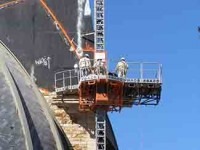September 2010
Mast Climbers
By Jacques Lainé
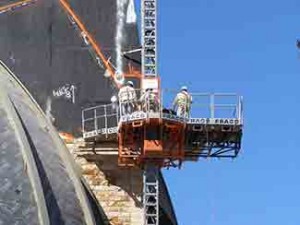
Fraco’s FRSM20K units were used to help stonelayers to complete the front and rear façades of that brand new oratory.
The major economic downturn of the late-2000s has had negative effects for the manufacturers of mast climbing work platform (MCWP).All agree that, like other industrial products, expenses (purchases and rentals) for MCWP had practically fallen flat, a situation that reflects the absence of private and public investment in traditional sectors of construction since the stock market crash of 2008. This shortage of construction projects has resulted in intensified competition in the industry of MCWP. Some manufacturers have decided to challenge the crisis by sticking to their own product/market (single MCWP for single market). Others saw the crisis coming and planned a new definition of their market strategies.
State of the industry – Late-2000s
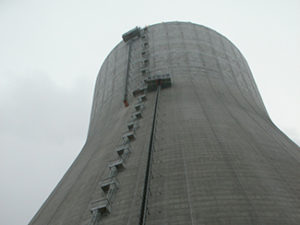
One ACT-8 unit was modified and used to transport workers along the 437′ high exterior wall of a new natural draft hyberbolic cooling tower
The growth of the demand for MCWP has increased in the second half of the ‘90s, a gain influenced by the overall economic growth of the 2000s. In the late-2000s, the industry of MCWP in North America consisted primarily of four manufacturers (Fraco Products Ltd., Hydro Mobile, EZ Scaffold and Klimer), with few additional speakers (Hy-Dek, Alimak Hek, American Mast Climbers, Dunlop Mastclimbers, Premier Scaffolding Solutions, etc.). Having been the first to really take off in the industry, Fraco Products Ltd. and Hydro Mobile remain the two main manufacturers at the end of the decade.
The MCWP manufacturers offer mostly one or two products, but some offer a broader line of products. The business approach of most manufacturers is to offer their products by focusing on a market. Masonry, which represented the largest application market for MCWP, remains today the most important market. At the end of the period, almost all manufacturers are serving the North American market. Only Fraco has a truly international profile with a strong presence in Europe, Asia and the Middle East.
Market-driving approach
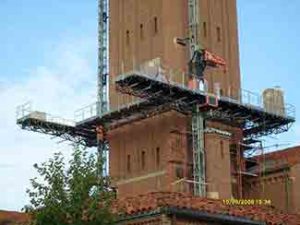
Two ACT-8 Fraco units with cranes and bearing bridges were used to repair all four corners of the bell tower
The first phase of development of MCWP in North America was characterized by a product-oriented approach. Manufacturers focus on the characteristics of products offered or emphases on certain features that are the basis of differentiation from competing products. This approach influences the emergence of different products that distinguish themselves by their high loading capacity and speed of elevation.
In January 2008, Fraco Products Ltd. defined itself as a supplier of mast climbing access systems. The company went further by moving away from certain niche markets and focusing on segments of the construction market that provide an obvious potential of growth. Therefore, there is no question of simply responding to specific requests from non-traditional market segments. The masonry remains the main niche to be served, but new opportunities are identified: glazing, infrastructures, demolition and power generation. Each of these niches requires changes to products or adding new accessories that allow Fraco Products to adapt to specific realities. Also, the establishment of a market-driven approach does not suit all companies. To achieve this, it is important to have expertise in each niche, an advantage that grows over the years. An organizational culture that focuses on an entrepreneurial approach in each segment also is a key factor for success.
If we consider the infrastructure segment, Fraco has been able, during the last two years, to adapt its products and services to become a leader for the repair of highways and bridges pillars. It is the same for the power generation niche; dams and cooling towers are often characterized by sloping walls that require access systems tailored to them. Fraco has understood this reality and offers to this clientele different technical services to meet all kind of challenges. Demolition and deconstruction projects completed with mast climbing access systems are becoming more popular. It seems that MCWP are well suited for chimney demolition projects, when buildings around the chimney need to be protected. Fraco has imported its expertise from its people from France, where that kind of work has been realized several times. The glazing segment represents the fourth segment of the construction market to present a lot of potential for the future. Fraco has adapted some of its accessories as the monorail system to be compliant with the tools normally used by the glazing market.
The Fraco model
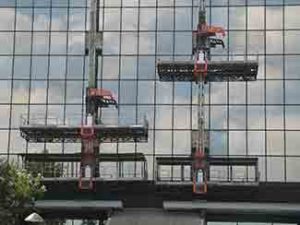
Several stacked Fraco platforms with portable cranes were used for anti-seismic retrofit works. All windows were replaced.
As mentioned, the masonry niche remains an important market for the MCWP manufacturers. In order to increase the productivity in that segment, Fraco Products has conducted several analyses with masonry contractors to fully understand the sources of productivity for theses businesses. The result of these studies is the Fraco model, a model that promotes a new working environment for the bricklayer.
With the Fraco model, the bricklayer is able to affect more time to its competence and specialization, i.e. laying bricks, blocks and stones and other masonry actions. The model involves a new definition of the relation between bricklayers and laborers. Laborers are no more considered as providers of material; they are now members of a supply chain and they participate to the overall performance of a team. This model also moves into a new definition of the workspace offered by a mast climbing work platform. The bricklayer can now benefits from increased room and better utilization of resources.
In order to translate the Fraco model into an operational reality, Fraco has developed a production table (see images) which increases the room on the platform and allows the storage of all the components, other than bricks and mortar. Tools and material like flashing, wall ties, etc., can now be stored underneath that production table, thus creating a new workspace. This allows the mason to lay bricks without having to ask the laborer to bring one thing or another. The production table is interrupted by a one-foot opening to give access to the laborer. That way, he can easily access the bricklayer zone to assist in the application of wall ties, seals, windows protections and other material. In fact, the aim of the Fraco model is not to increase the mason’s rhythm but to allow him to concentrate on bricklaying.
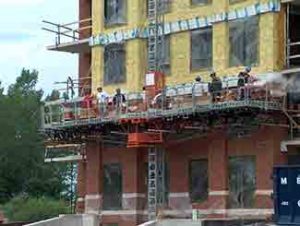
A single mast FRSM-20K unit is being used as a real production center for the masonry works of a new 5 storey building.
The model requires a good planning from the foreman. Thus, at the end of the day, he prepares a work sheet (Fraco Planning Form) for the next day of work. He populates that form by indicating the list of material that will be needed to serve bricklayers the next day, and he provides that list to concerned people (laborers, forklift operators, etc.)
The next morning, when the laborer shows up to the jobsite, he does not need to go up to organize the workspace on the platform. He takes the time to prepare his pallet with all accessories and tools other than mortar and bricks necessary for his day of work. Once he is ready, he gets on his platform, and the forklift operator brings him his pallet. In the Fraco model, a copy of the foreman’s work sheet also is provided to the forklift driver, so that he knows the number of bricks, blocks and mortar pans that will be required for the day.
With the Fraco model, the initial objectives are achieved, and a real teamwork culture is being applied on the jobsite. The model also creates better planning, improved communication and greater commitment from everyone.
Conclusion
The recent economic crisis has modified and keeps modifying the status of MCWP manufacturers. Some of them certainly will get out of the crisis in a weaker financial situation than two years ago. The intensity of the construction activities will not come back to its level of the first decade. MCWP manufacturers have to think outside the box and evaluate their marketing approaches. A step was taken, and it is now time to adjust to the next one.
Jacques Lainé is director of marketing for Fraco Products Ltd., St.Mathias, Quebec, Canada. He can be reached at jacques.laine@fraco.com.
